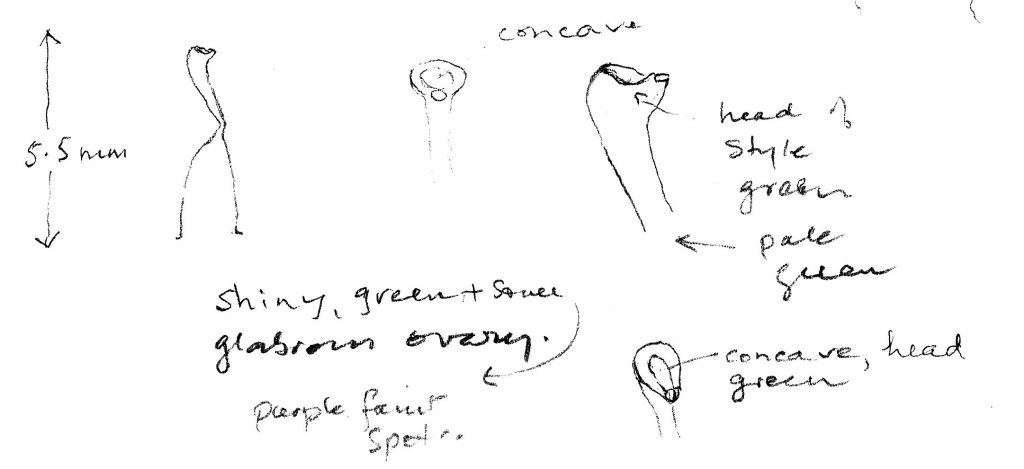Viola missouriensis, Greene
Kim’s notes, unedited. Illustrations: 7 photographs of Viola missouriensis and 2 drawings.
Pittonia 4: 141. 1900.
Type locality: Leeds, Missouri.
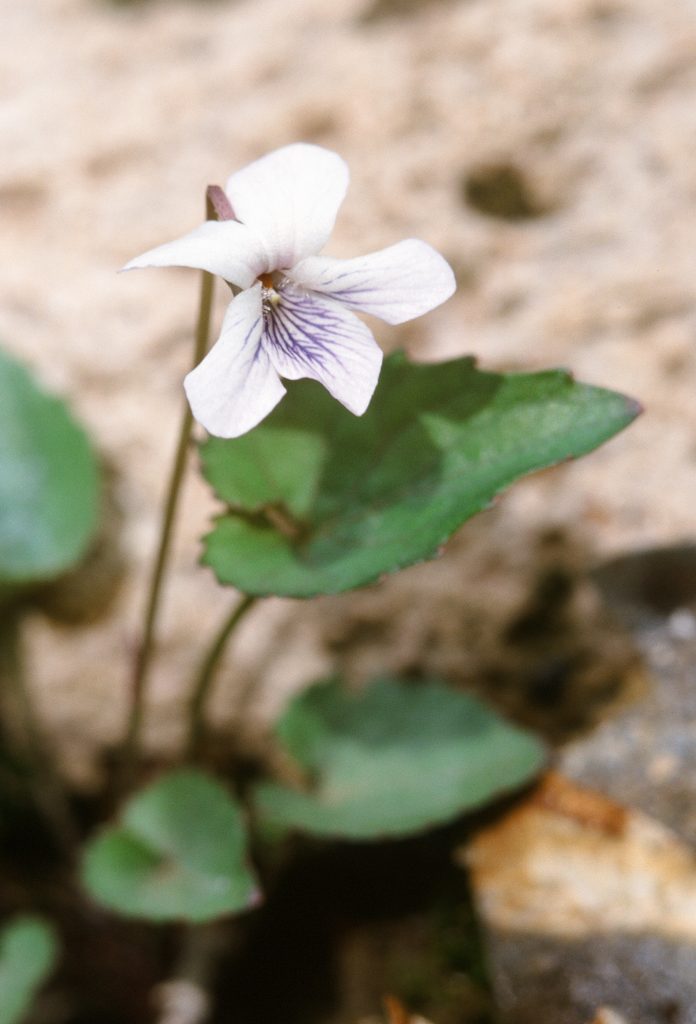

Range: Missouri to Oklahoma and northeastern and southern New Mexico, western Texas (Guadalupe Mtns.).
Edward Lee Greene, 1843-1915.
TM: Section Nosphinium, subsect. Boreali-Americanae [NEW classification, 2010].
IPCN gives only one count that I think cannot be correct. It is 2n=48, Kessler J.W., 1983. It should be 54.
This species is recognized by McKinney, L.E. & N.H. Russell. 2002, Violaceae of the southeastern United States. Castanea. 67(4): 369-379.
Harvey says ‘along river banks’. Fits with plants in New Mexico just over the border from Texas in the Guadalupe Mountains.
Leaves deltoid.
Photographed in Missouri beside the banks of the Missouri River, and Perche Creek, Boone County.
www.missouriplants.com, written and photographed by Dan Tenaglia, now in Alabama, killed in bike accident (friend of Carol Lim):
Habitat – Low rich alluvial soils or woodlands, ravine bottoms, low thickets, along or near streams. This Violet can be found throughout Missouri. The plant can be identified by its triangular-cordate leaves and lilac flowers. The flowers are lighter in color than the more common Viola sororia Willd. Flowering: March – May. Stems – Petioles glabrous, +/-12cm long. Stipules linear-attenuate, whitish [colourless], glabrous, to +/-2cm long, to 2mm broad at the base. Blades cordate at the base (some merely rounded). Mature leaves triangular-cordate, longer than broad, tapering to an acute apex, crenate-serrate, glabrous, dull-dark green above, light green below, to +5cm long, +3cm broad.
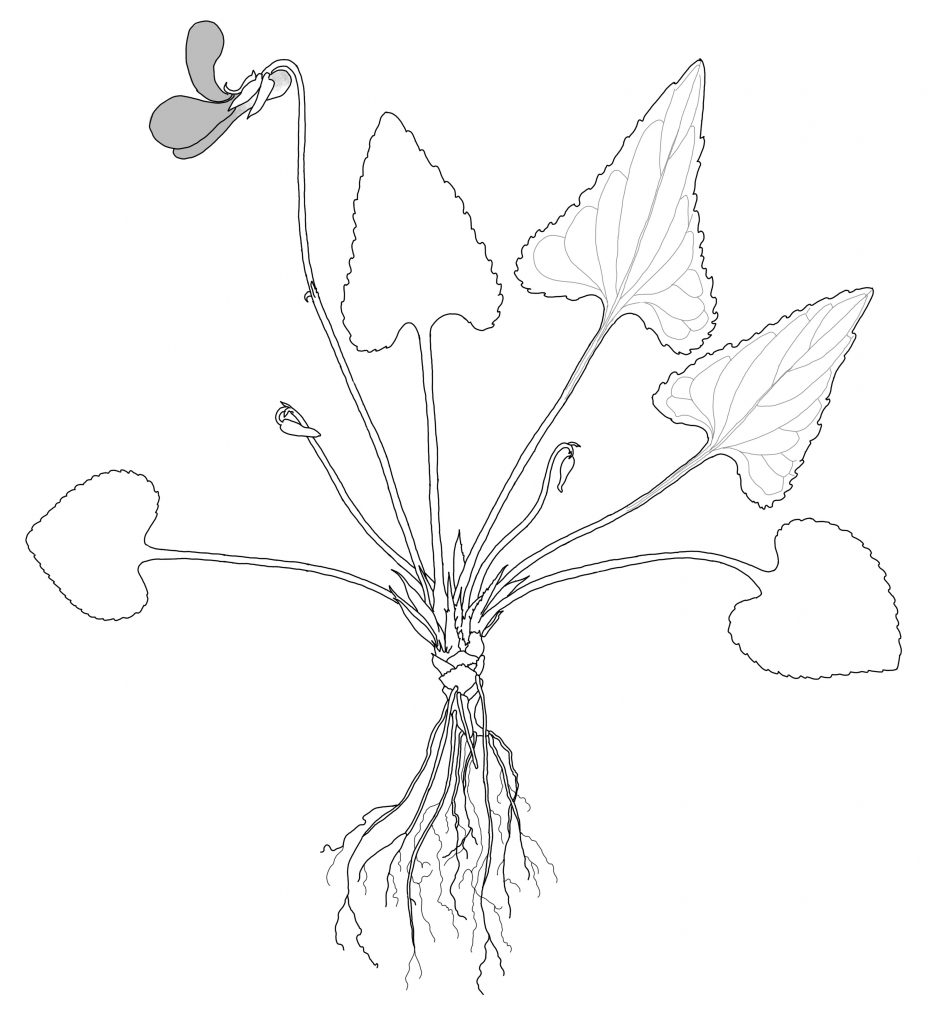
Inflorescence – Multiple pedunculate flowers arising from the base of the plant. Flowers typically equal to or exceeding the leaves. Peduncles glabrous, to +12cm long, with a pair of opposing or alternate bracts about 1/2 way up the peduncle. Bracts glabrous, minute, lanceolate, +/-3mm long, 1mm broad. Petals lilac, white at the base, with darker purple veins. Lateral petals bearded (the hairs 2mm long). Petal spur to 3mm long). Ovary green, 3mm long, 2mm in diameter, cylindric-ovoid, glabrous. Stigma greenish, 1mm broad, truncate. Photographs (see i-Photo violets) taken at Eagle Bluffs Conservation Area, Boone County, MO., 4-18-04.
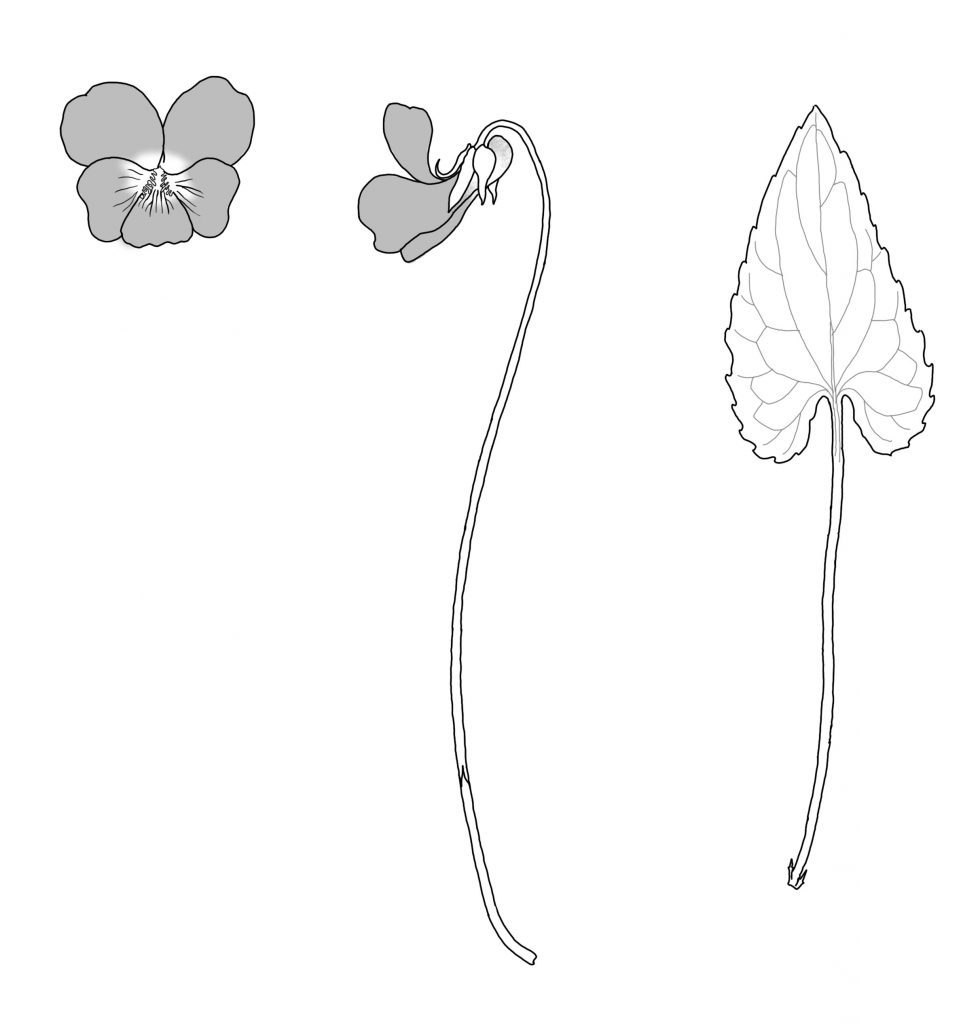
The leaves of V. missouriensis, in Guad. Mtns N.P., are similar in shape to the plants from Tennessee, near the large dam east of where I rented the car, also in the State Park where V. egglestonii was growing (no photo, but good drawing). They are growing in very similar conditions, limestone seeps, with constant moisture. The photos of V. missouriensis, in the park’s collection, showed, on the basal lobes of the leaves, exaggerated lobe-like curled teeth each with a prominent terminal gland. The white flowers had hairs on the lateral petals, also on the herbarium specimen at the N.P. headquarters, but I couldn’t see any hairs on the keel petal, in either slide or herbarium specimen. There was heavy purple veining on the keel petal. Fred said that the flowers are not usually so white, usually with a blue wash through the petals. One slide in the N.P. collection showed V. missouriensis growing out of a rockface, like Viola f-smithii, with the dead persistent leaves from the previous year hanging down below the plant. This plant had prominent curling basal-lobe teeth which showed well in the photograph. The leaves of V. missouriensis are similar in shape to the larger one on photocopied type herbarium specimen of V. clauseniana that Margaret Malm copied, ex Californian herbarium. However, V. clauseniana has no hairs on the lateral petals, and a chromosome count of n = 22. The leaf bases of V. clauseniana did not have very exaggerated lobe-like curling teeth as seen in V. missouriensis at Guadalupe Mtns., Texas.
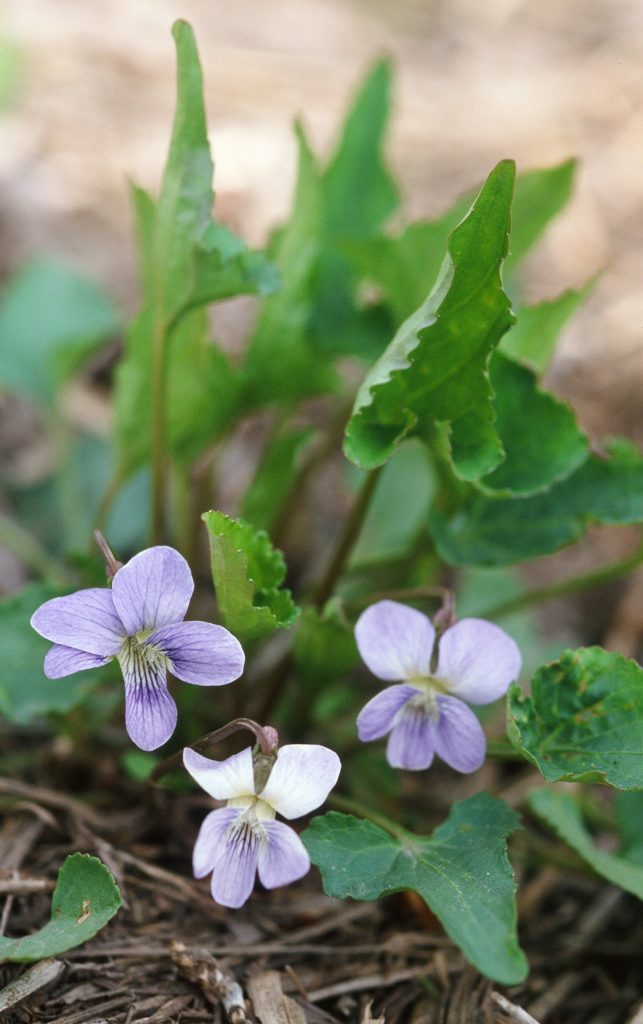
www.backyardnature.net/ n/02/020317.htm In Natchez, the Missouri Violet, V. missouriensis has heart shaped leaves like the Common Blue Violet, V. sororia but has pale lavender flowers. It often grows with V. sororia but is not as common. Mid-March.
Leaves deltoid. [Klaber, p.22]
Acer grandidentatum, yellow Aquilegia chrysantha (syn. chaplinei) and maidenhair fern Adiantum capillus veneris were growing at the V. missouriensis site where I found it on my first walk, growing out from under one of the big rocks for sitting, at the spring (Smith Spring, see below). May 2001.
Plants in the Guadalupe Mountains come from three directions: south from the Rocky Mountains, west from Texas, and north from Mexico.
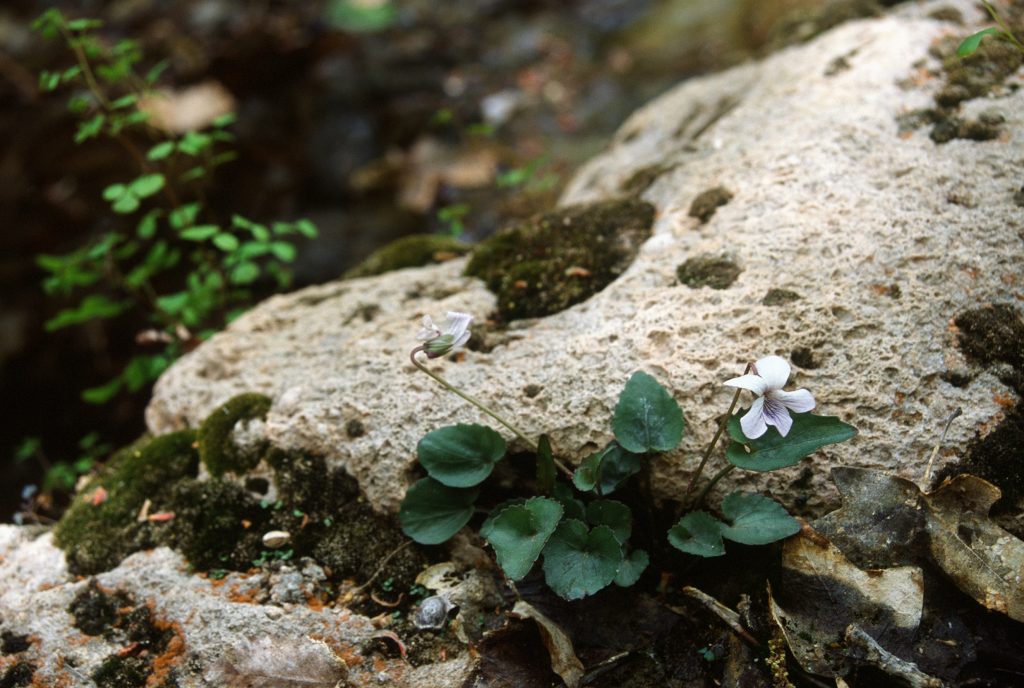
The herbarium specimens of Big Bend N.P., Guadalupe Mountains N.P. and Sul Ross University have been combined into one data base. No viola species in Big Bend herbarium collection. In Sul Ross, there are collections of V. missouriensis, from the Guadalupe Mountains National Park, from several locations, from South McKittrick (5500, 5800, 6000, 6200 ft), North McKittrick, and SmithSpring (6000 ft).

2002, April 27, walked up McKittrick Canyon, N. fork just into New Mexico. Eventually found V. missouriensis in flower, growing beside the stream of the middle fork, near the confluence of the north and middle canyons, in tufa, 1755 m, with Aquilegia chrysantha (syn. chaplinei), Pinus ponderosa, Pinus douglasiana, Adiantum capillus veneris, Cladium jamaicense, Ostrya knowltonii (Hophornbeam), Arbutus texensis and Quercus muhlenbergii.

Zurich herbarium :
Teeth towards the tip very far apart, at base much closer and teeth exaggerated (like waves), middle and base attenuate, same as in Guadalupe Mntns. Nat. Park, Texas.
Niehaus, T.F., Ripper, C.L., & Savage, V., A Field Guide to Southwestern and Texas Wildflowers (Roger Tory Peterson Field Guides), 1984.: Triangular leaf blade with none to 6 teeth on upper third of blade. Flowers light blue. 5-15 cm. Common in woods. Central and NE Texas, New Mexico, and Plain States. Flowers March to May.
INVENTORY OF THE FLORA OF THE GUADALUPE MOUNTAINS, NEW MEXICO AND TEXAS [SECOND WORKING DRAFT] [MARCH, 2002]. Compiled by: Richard D. Worthington, Ph.D. Floristic Inventories of the Southwest Program, P. O. Box 13331, El Paso, Texas 79913.:
VIOLA SORORIA Willd. var. MISSOURIENSIS (Greene) McKinney Sister Violet [Russell, 1962; Northington & Burgess, 1979; Burgess & Northington, 1981; McKinney, 1992] [Patterson 501: TEX-LL] Note: The Patterson collection (no. 501, TEX-LL) appears to have been a mixed collection of the two taxa noted above. The collection was made in North McKittrick Canyon near the Otero-Eddy Co. line.
Atlas of the Flora of the Great Plains: Viola missouriensis has been recorded from the south-eastern region of the Great Plains [Oklahoma, Arkansas, Kansas, Nebraska and Iowa, Missouri, with a few collections in eastern South Dakota and southern Minnesota, with one county in North Dakota]. It grows in alkaline soils. The distribution is centered in the eastern Kansas-western Missouri area, but also grows further east in the east of Tennessee. Is the limit of the northern range governed by temperature? Too cold? Also in sw Texas and adjacent New Mexico in the Guadalupe Mountains. It does not occur in the Rocky Mountains of Colorado, Wyoming or Montana.
Peterson Field Guide says: V. missouriensis is similar to V. sororia but note the triangular leaf shape with outer margins often folded (leaf lobes curled upwards and inwards). Flowers paler blue, with a white centre. Low woods, floodplains, creek banks. Iowa, Illinois, Indiana south, flowering April-May.
Mike Slater saw V. missouriensis in late March, 2010 in VanZandt Co. TX, Near Tyler, also photos saved in Violas US.
From Fred Armstrong, 23 Sep 2009:
Dear Kim,
Here is some recent information gained from the botanist who discovered the violet in Big Canyon on the Lincoln NF, and that Harvey Ballard subsequently visited. In this photo it looks alot like the violets that we saw in North McKittrick Canyon. This tells me that our violet from Bear Canyon may possibly be another species. I hope you have success with some of the seed.
Fred
—– Forwarded by Fred Armstrong/GUMO/NPS on 09/23/2009 12:12 PM —–
Paul Knight
om>
09/23/2009 07:16 AM
Subject Violet in Big Canyon
Fred:
I am sorry it to so long to get back with you, but I have been out in the field. Neither of the violets that you sent me pictures of are even remotely like the one we found in Big Canyon. I have attached a photograph of our violet taken in 1987. The specimen shown in the photo is mostly white with lavender in the throat but many of them have flowers that are tinged with a lavender color throughout. The plant is very diminutive, the leaf blades being only about 2 cm long (or less). It flowers in March to early April. It always grows either from cracks and fissures in rock faces or occasionally in pockets in the rock normally on cliffs, but occasionally on large limestone boulders. Although mostly found on north aspects there were some on east and west facing rocks. The leaves are thickened, and occasionally wavy or crisped in a profile view. It is locally common on cliff faces in the lower reaches of the south fork of Big Canyon. Some plants occur not far from the mouth of the canyon at about 5000 feet in elevation. Most of them that I have found occur between 5000-5800 feet in elevation. Judging by your photos and mine it looks like there may be at least three distinct and unique violets in the Guadalupe Mountains. Let me know what you find out about them.
Paul Knight
Kim to Harvey:
Fred Armstrong from the Guadalupe Mountains N.P. sent me this email. I think it looks very like Viola missouriensis that Fred and I saw growing in the northern McKittrick Canyon of the Guad. Mts. N.P. just across the state border from Lincoln N.F. HOWEVER I have just looked back through my pictures of V. missouriensis flowers from there and from Missouri and none have the narrowing short lowest petal with emarginate end. Is this the violet you went to see? Or was it the sagittate/palmate leafed plant of which I sent you a photo recently? This latter plant does not have an emarginate lowest petal either.
H. Ballard, 1 Oct, 2009:
The Guadalupe Mtns violet may well (almost surely is) the same one I think is an undescribed species of acaulescent blue…it’s been found so far in southern New Mexico and (I think, though my memory may be faulty) also on the Texas side in the same mountain range. I saw it in flower and cleistogamous fruit many years ago on the New Mexico side. It is somewhat variable. Plants at the lowest elevations were virtually white-flowered, but as we climbed up the mountain side, flower color became flushed with purple and then was decidedly pale purple at the top. Also, some plants were heterophyllous, with earlier-season leaves unlobed and mid-season leaves ON SOME PLANTS (not all) shallowly lobed. But the plant is distinctly different, to me, from V. viarum in leaf lobing, subtle features of flower and also the habitat (both are on limestone usually, but the NM/TX plants grow on mountain- or cliffside crevices, and V. viarum is characteristically on riverside limestone). So, I do believe it’s distinct, but both critters need some more study. A number of entities, perhaps some of hybrid origin, have unfortunately been thrown into the name “Viola viarum”, but when I studied it over southern Missouri and Arkansas on limestone terraces of streams and rivers, at least that taxon was very straightforward, but not the same as the southwestern violet. They are likely closely related, though. [Sounds very like what Fred Armstrong show me up the McKittrick Canyon.]
